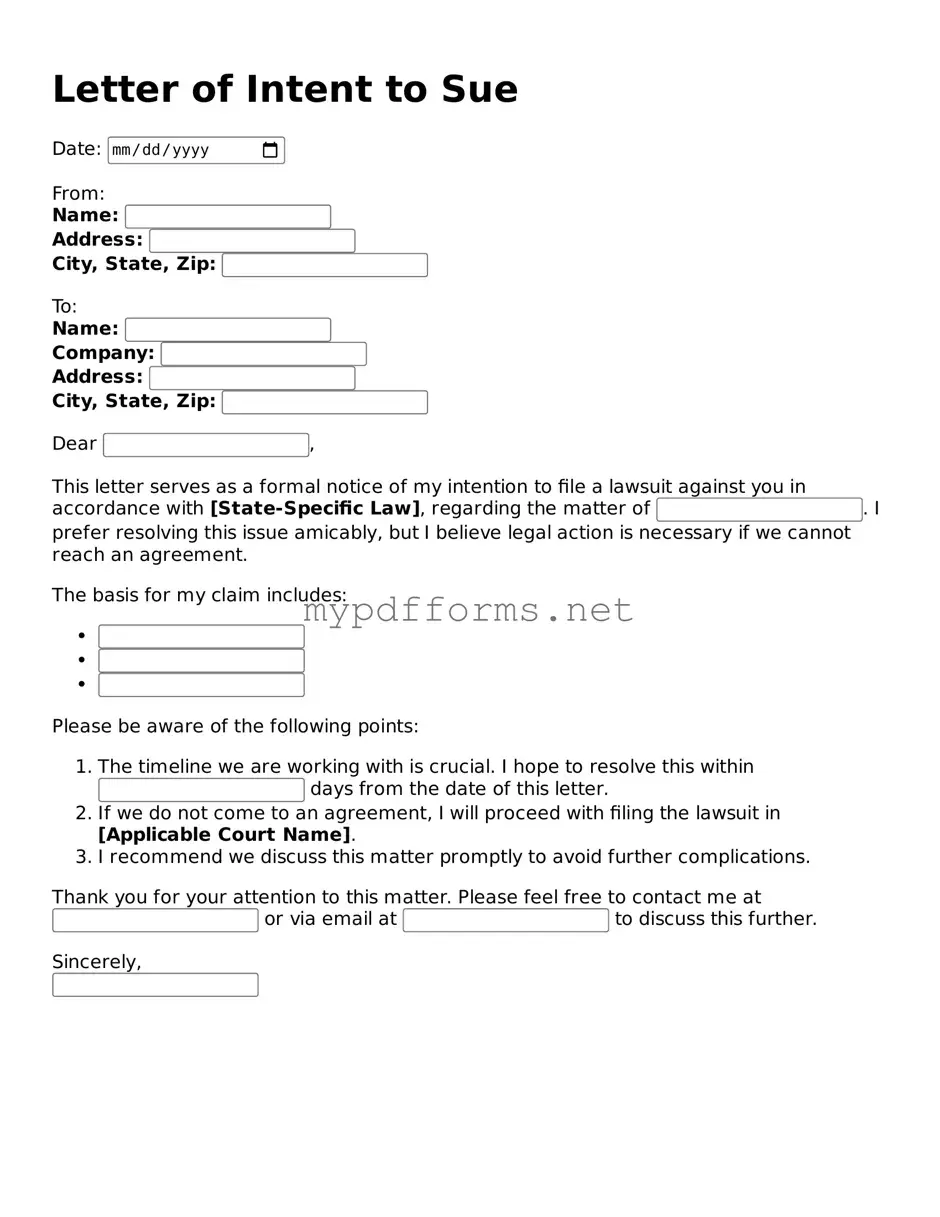The Letter of Intent to Sue form shares similarities with a Demand Letter. A Demand Letter is often the first formal step in a dispute, outlining the grievances and the desired resolution. Like the Letter of Intent to Sue, it serves as a notice to the opposing party that legal action may follow if the issue is not resolved. Both documents aim to prompt a response from the other party, potentially allowing for negotiation and settlement before escalating to litigation.
Another document comparable to the Letter of Intent to Sue is the Notice of Claim. This document is typically used in cases involving government entities. It informs the government of the intention to file a lawsuit, providing them with an opportunity to address the claim before formal litigation begins. Similar to the Letter of Intent to Sue, a Notice of Claim sets the stage for possible resolution outside of court, emphasizing the importance of communication in dispute resolution.
The Cease and Desist Letter is also akin to the Letter of Intent to Sue. This document is often sent to individuals or organizations to halt alleged illegal or infringing activities. Like the Letter of Intent to Sue, it communicates a serious intent to take legal action if the recipient does not comply with the demands outlined within it. Both documents serve as a warning, aiming to prevent further escalation of the conflict.
In addition, the Pre-Litigation Notice bears similarities to the Letter of Intent to Sue. This document is used to inform the opposing party of a potential lawsuit and outlines the claims that may be brought against them. It often includes a request for a meeting or discussion to resolve the matter before it reaches the courts. Both documents emphasize the need for dialogue and resolution, highlighting the potential consequences of ignoring the notice.
The Indiana Homeschool Letter of Intent form is an essential step for families choosing to homeschool, as it requires parents to formally notify the state of their educational plans. To ensure compliance with the necessary regulations, families should carefully prepare this document, and they can download and fill out the form to initiate the homeschooling process smoothly.
The Complaint, while more formal and comprehensive, shares a goal with the Letter of Intent to Sue: to initiate legal proceedings. The Complaint details the allegations and legal basis for the lawsuit, whereas the Letter of Intent to Sue serves as a preliminary warning. Both documents are critical in the legal process, but the Complaint represents the actual filing in court, while the Letter of Intent is a precursor meant to encourage resolution.
The Settlement Proposal is another document that resembles the Letter of Intent to Sue. This document is often used to outline terms under which the parties can resolve their disputes without going to court. Like the Letter of Intent, it indicates a willingness to negotiate and find common ground, aiming to avoid the costs and uncertainties associated with litigation.
The Mediation Request also shares characteristics with the Letter of Intent to Sue. This document invites the other party to engage in mediation, a process designed to facilitate negotiation and resolution with the help of a neutral third party. Both documents highlight the importance of finding a solution outside of court, promoting communication and collaboration between the parties involved.
The Arbitration Demand is similar as well, as it initiates an alternative dispute resolution process. This document requests that the dispute be resolved through arbitration rather than litigation. Like the Letter of Intent to Sue, it signifies a serious intent to address the conflict, but it does so by proposing a structured, binding resolution process instead of court action.
Lastly, the Release Agreement can be compared to the Letter of Intent to Sue. While it is typically used after a dispute has been resolved, it serves to formalize the terms of that resolution. Both documents reflect a desire to settle disputes, though the Release Agreement finalizes the resolution, whereas the Letter of Intent to Sue serves as a precursor to potential legal action. Each plays a crucial role in the broader landscape of conflict resolution.
